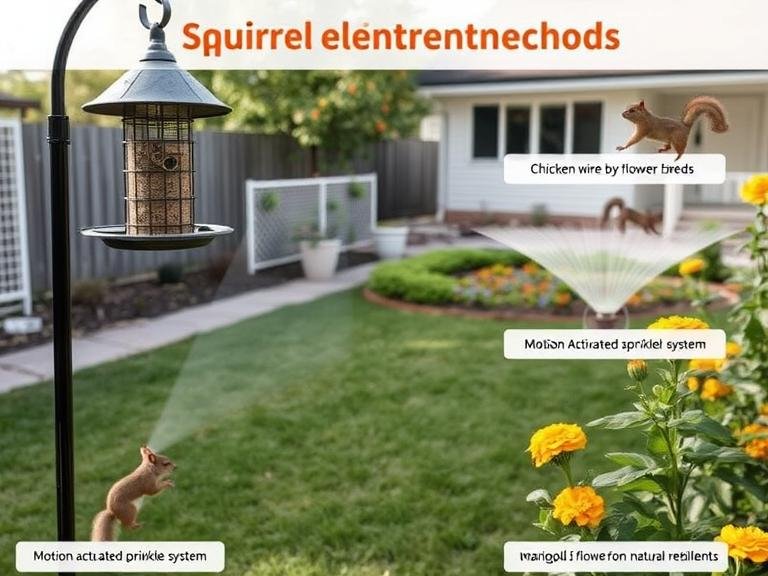How to Keep Squirrels Away: Squirrels may appear cute and harmless, but these persistent creatures can quickly become a homeowner’s nightmare. From raiding bird feeders to damaging gardens and even infiltrating attics, squirrels possess an uncanny ability to find their way into spaces where they’re unwelcome. Understanding effective methods to deter these agile rodents requires a combination of knowledge about their behavior, proven prevention techniques, and consistent implementation of control measures.
Table of Contents
Understanding Squirrel Behavior and Motivation
Before implementing any deterrent strategy, it’s essential to understand what attracts squirrels to your property in the first place. These resourceful animals are primarily motivated by three basic needs: food, shelter, and water. Squirrels are opportunistic feeders with an exceptional memory for food locations, often returning repeatedly to reliable sources.
Their natural curiosity and problem-solving abilities make them particularly challenging to deter. Squirrels can jump horizontally up to 10 feet and vertically up to 4 feet, making seemingly inaccessible areas vulnerable to their intrusion. They also possess strong teeth that continuously grow, driving them to gnaw on various materials to keep their teeth properly maintained.
Natural and Humane Deterrent Methods
Scent-Based Repellents
One of the most effective approaches involves using scents that squirrels find offensive. Cayenne pepper serves as an excellent natural deterrent when sprinkled around targeted areas. The capsaicin in hot peppers creates an unpleasant sensation for squirrels without causing permanent harm.
Coffee grounds, particularly used ones, can be scattered around garden beds and other vulnerable areas. The strong aroma and slightly acidic nature of coffee grounds make them unappealing to squirrels while simultaneously benefiting soil quality as they decompose.
Essential oils, particularly peppermint and eucalyptus, create aromatic barriers that squirrels prefer to avoid. These oils can be applied to cotton balls and strategically placed around problem areas, requiring regular refreshing to maintain effectiveness.
Physical Barriers and Modifications
Creating physical obstacles represents one of the most reliable long-term solutions for squirrel prevention. Installing metal baffles on bird feeder poles prevents squirrels from climbing up to reach food sources. These cone-shaped or cylindrical barriers should be positioned at least 4 feet from the ground and 8 feet from any jumping surface.
Wire mesh or hardware cloth can protect garden beds, bulbs, and newly planted areas. Choose mesh with openings smaller than 1 inch to prevent squirrels from squeezing through. For protecting individual plants or small garden sections, floating row covers provide an effective temporary solution.
Tree guards made from smooth metal or plastic wrapped around tree trunks prevent squirrels from climbing up to access roofs, attics, or bird nests. These guards should extend at least 6 feet from the ground and fit snugly around the trunk without damaging the bark.
Garden Protection Strategies
Protecting Bulbs and Plants
Squirrels have a particular fondness for flower bulbs, especially tulips and crocuses. Creating a protective layer of chicken wire or hardware cloth over newly planted bulbs prevents digging while allowing plants to grow through the openings. Remove the wire once plants are established and less appealing to squirrels.
Companion planting with naturally repellent plants can create a protective barrier around vulnerable crops. Marigolds, nasturtiums, and alliums produce scents that squirrels tend to avoid, making them excellent border plants for vegetable gardens.
Alternative Food Sources
Providing designated feeding areas away from gardens and bird feeders can redirect squirrel attention. Corn cobs or specialized squirrel feed placed in remote corners of the property may satisfy their dietary needs while keeping them away from more sensitive areas. However, this approach requires careful consideration, as it may attract additional squirrels to the property.
Technology-Based Solutions
Motion-Activated Devices
Modern technology offers several sophisticated options for squirrel deterrence. Motion-activated sprinklers provide an immediate and harmless response to squirrel intrusion. These devices detect movement and release a sudden burst of water, startling squirrels and encouraging them to seek alternative locations.
Ultrasonic repellers emit high-frequency sounds that are uncomfortable for squirrels but generally inaudible to humans. While effectiveness varies depending on environmental factors and individual squirrel sensitivity, these devices offer a non-invasive option for continuous deterrence.
Solar-Powered Options
Solar-powered deterrent devices provide sustainable, long-term protection without requiring electrical connections or battery replacements. These systems often combine multiple deterrent methods, such as flashing lights, sounds, and motion detection, creating a comprehensive defense system.
Structural Modifications for Long-Term Prevention
Roof and Attic Protection
Preventing squirrel access to roofs and attics requires systematic inspection and modification of potential entry points. Install chimney caps and vent covers to block access routes while maintaining proper ventilation. Trim tree branches to create at least a 10-foot gap between foliage and roof lines, preventing squirrels from jumping onto structures.
Seal gaps and holes in soffits, eaves, and fascia boards using hardware cloth or metal flashing rather than materials that squirrels can chew through. Pay particular attention to areas where utilities enter buildings, as these often provide convenient access points.
Gutter and Downspout Modifications
Installing gutter guards prevents squirrels from using gutters as highways along roof lines. Choose guards with small openings that allow water flow while blocking squirrel access. Ensure downspouts are properly secured and consider adding metal sleeves to prevent climbing.
Seasonal Considerations and Timing
Squirrel behavior varies throughout the year, making timing an important factor in deterrence strategies. Fall represents peak activity as squirrels prepare for winter by gathering and storing food. Implementing prevention measures before this seasonal surge proves more effective than responding after problems develop.
Spring brings nesting activity, with pregnant females seeking secure locations for raising young. Identifying and blocking potential nesting sites during late winter prevents establishment of squirrel families on your property.
Winter feeding becomes more critical as natural food sources diminish, making bird feeders and stored items particularly attractive. Maintaining deterrent measures throughout winter prevents hungry squirrels from developing persistent habits around your property.
Maintenance and Monitoring
Successful squirrel deterrence requires ongoing attention and periodic adjustment of strategies. Regular inspection of physical barriers ensures continued effectiveness, as weather and time can compromise installation integrity. Replace or refresh scent-based deterrents according to manufacturer recommendations or weather conditions.
Monitor squirrel activity patterns around your property to identify emerging problem areas before they become established. Early intervention typically requires less intensive measures than addressing entrenched squirrel behavior.
Frequently Asked Questions
Q: Are there any plants that naturally repel squirrels? A: Yes, several plants naturally deter squirrels including marigolds, nasturtiums, alliums, daffodils, and plants in the mint family. These plants produce scents or contain compounds that squirrels find unpleasant.
Q: How high should barriers be to effectively keep squirrels out? A: Barriers should be at least 4 feet high, as squirrels can jump vertically up to 4 feet. For climbing barriers on poles or trees, extend protection 6-8 feet from the ground to account for their jumping ability.
Q: Do mothballs effectively repel squirrels? A: While mothballs contain chemicals that may deter squirrels, they’re not recommended due to toxicity concerns for pets, children, and the environment. Safer alternatives like cayenne pepper or essential oils provide effective deterrence without health risks.
Q: How often should I reapply natural repellents? A: Natural repellents typically need reapplication every 1-2 weeks or after rain. Weather conditions, sprinkler systems, and the specific product used will affect longevity, so monitor effectiveness and refresh as needed.
Q: Can squirrels damage my home’s structure? A: Yes, squirrels can cause significant structural damage by chewing through wood, insulation, and even electrical wires. Their continuously growing teeth drive them to gnaw constantly, making prevention crucial for protecting your property.
Q: What time of year are squirrels most active? A: Squirrels are most active during fall months when they’re gathering food for winter storage. They also show increased activity in early spring during mating season and when establishing nesting sites.


